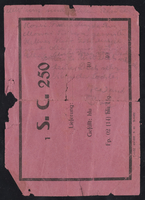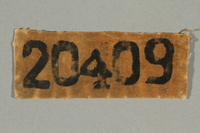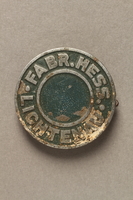Overview
- Brief Narrative
- Heart shaped leather charm with a small, rectangular, leather wrapped piece of paper, thin leather, or a portion of a Torah page reminiscent of a Mezuzah. It was made by prisoners in Auschwitz concentration camp in German-occupied Poland, and worn on a camp issued wooden clog by Ilona Kellner (later Elena Kalina), while a prisoner at two camps between June 13, 1944 and April 25, 1945. During the 1930s, Ilona worked as a kindergarten teacher in Rožňava, and lived in Pelsöc, in what was Czechoslovakia until 1938, when it became part of Hungary (now Plešivec, Slovakia.) Her parents, Karoly and Jolan, and younger sister, Vera, also lived there. In 1938, Hungary’s fascist regime adopted anti-Semitic measures based upon the Nuremberg racial laws in Germany. In November 1940, Hungary joined the Axis Alliance. In March 1944, Germany invaded Hungary and began deporting all Hungarian Jews to concentration camps. On May 8, 1944, the authorities forced Ilona, Vera, and their parents, Karoly and Jolan, from their home and moved them into a ghetto that had been set aside in another area of the town. In mid-June, the family, was deported to Auschwitz. Their parents were taken to the gas chambers in the camp’s killing center, Birkenau, and killed upon arrival. By August 2, Ilona and Vera had been deported to Hessisch Lichtenau, a sub-camp of Buchenwald concentration camp as part of a transport of 1,000 Hungarian women brought to Germany to fill a labor shortage. On September 19, Ilona and Vera were officially registered at the camp, and issued prisoner patches. The women worked in an explosive munitions factory run by Fabrik Hessisch Lichtenau GmbH. In late March 1945, the camp was evacuated and the women were taken to Leipzig by train. From there, they were sent on a forced march to Wurzen, where they were liberated by US forces on April 25.
- Date
-
creation:
1944 June 13-1944 July
use: 1944 June 13-1945 April 25
- Geography
-
creation:
Auschwitz (Concentration camp);
Oświęcim (Poland)
use: Auschwitz (Concentration camp); Oświęcim (Poland)
use: Hessisch Lichtenau (Concentration camp); Hessisch Lichtenau (Germany)
- Credit Line
- United States Holocaust Memorial Museum Collection, Gift of Eva Moreimi, in loving memory of her parents: Ilona Kellner Kalinova and Ernest Kaufmann Kalina
- Contributor
-
Subject:
Ilona Kellner
- Biography
-
Ilona Kellner (later Elena Kalina, 1912-2011, some records list her year of birth as 1916) was born in Pelsöc, Austria-Hungary (now Plešivec, Slovakia) to Karoly (1887–1944) and Jolan Freimann (1890-1944) Kellner. Ilona had one younger sister, Vera (1927 -2017, some records list her year of birth as 1922). Karoly was a merchant. Ilona was unmarried and worked as a kindergarten teacher in Rožňava. Following World War I, Pelsöc had become part of Czechoslovakia, and became a part of Hungary in approximately 1938. During the 1930s, Hungary was an ally of Nazi Germany, and in 1938, Hungary’s fascist regime adopted anti-Semitic measures based on the German Nuremberg racial laws. In November 1940, Hungary joined the Axis Alliance, and participated in Operation Barbarossa, the June 1941 German invasion of the Soviet Union.
After the German retreat from Stalingrad in February 1943, Hungary sought a separate peace with the Allies. In March 1944, Germany invaded Hungary and began deporting all Hungarian Jews to concentration camps. On May 8, 1944, the authorities forced Ilona, Vera, and their parents, Karoly and Jolan, from their home and moved them into a ghetto that had been set aside in another area of the town. In mid-June, the family, was deported to Auschwitz concentration camp in German occupied Poland. Their parents were taken to the gas chambers in the camp’s killing center, Birkenau, and killed upon arrival. By August 2, Ilona and Vera had been deported to Hessisch Lichtenau, a sub-camp of Buchenwald concentration camp as part of a transport of 1,000 Hungarian women brought to Germany to fill a labor shortage. On September 19, Ilona and Vera were officially registered at the camp, and were assigned prisoner numbers: Ilona was assigned 20409, and Vera 20407. All of the women in this transport were assigned numbers, by last name, between 20,001 and 21,003.
The camp provided labor for an explosive munitions factory run by Fabrik Hessisch Lichtenau GmbH zur Verwertung chemischer Erzeugnisse. The laborers lived in barracks on the edge of the local town, and marched under SS supervision, an hour and a half each way to the factory, which was deep in the woods and well camouflaged with plants, shrubs and trees planted around it and on the roof. At the factory, the women filled shells, bombs, mines, and cartridges with several different types of explosives in rotating shifts, while also carrying out dangerous and physically demanding tasks. The Jewish prisoners were typically placed in the most dangerous positions in the filling station and press building where they came into contact with poisonous acids and chemicals. They breathed in toxic vapors that turned some of the women’s skin yellow or were splashed and burned by corrosive chemicals, suffering permanent damage. Any prisoner not fit for work was quickly returned to Auschwitz. Ilona worked as a translator and messenger in the camp and when not doing those jobs, she cleaned up the factory. Her jobs gave her access to many areas and she was able to take blank forms from waste baskets in the camp to use as writing paper. The forms included munitions delivery and fulfillment receipts for ordnance, access passes, discharge bills, and shift inventories among other things. Ilona used the backs of the forms to record recipes dictated by her fellow female prisoners.
In late March 1945, as the United States army advanced on the region, the camp was evacuated. The women were taken to Leipzig by train, a five day trip. After a week there, the women were forced on a death march for two weeks, eventually arriving in Wurzen. On April 25, the survivors of the march, including Ilona and Vera, were liberated by US soldiers. On September 25, 1947, Ilona married Ernest Kalina (previously Kaufmann, 1909-2007), a Czechoslovak survivor of several forced labor camps during the war. His first wife, Irenka, their young daughter, Marika, his parents, Jenö and Etel, and several other relatives were killed at Auschwitz in 1944, and he lost a brother, Dönci, who was killed while serving as a forced laborer in the Hungarian army. Dönci had no food or proper clothing and often had to pick up unexploded mines and carry out other dangerous tasks. Ilona and Ernest had one daughter. In 1971, they immigrated to the United States and settled outside of Minneapolis, Minnesota.
Physical Details
- Classification
-
Jewelry
- Category
-
Necklaces
- Object Type
-
Pendants (Jewelry) (lcsh)
- Genre/Form
- Amulets.
- Physical Description
- Dark brown, textured leather, heart shaped ornament with two layers connected by a folded top edge and partially stitched together along the edges, with a small line of holes where the string is now missing. The v-shaped notch at the top is loosely stitched together and has smaller ornaments attached to it with a short length of twisted tan strings. At the end is a flat, leather rectangle with a pointed end and a rounded, rectangular, leather bundle stitched to the surface. Visible through a small, square window cut into the bundle’s face is tan paper with a black ink mark on it. Branching off the string is a knotted loop of brown string ending in a short, flat black plastic rectangle with pointed ends and a centered row of small holes. Intertwined among the string loops are multiple multi-colored threads. The strings are frayed and there is adhesive on one side of the heart.
- Dimensions
- overall: Height: 3.250 inches (8.255 cm) | Width: 1.250 inches (3.175 cm) | Depth: 0.125 inches (0.318 cm)
- Materials
- overall : leather, plastic, string, paper, ink, adhesive
Rights & Restrictions
- Conditions on Access
- No restrictions on access
- Conditions on Use
- No restrictions on use
Keywords & Subjects
- Topical Term
- Jews--Slovakia--Plešivec. Forced labor--Germany--Hessisch Lichtenau. World War, 1939-1945--Concentration camps--Germany--Hessisch Lichtenau. Explosives industry--Germany--Hessisch Lichtenau. World War, 1939-1945--Concentration camps--Poland--Auschwitz (Concentration camp) Holocaust, Jewish (1939-1945)--Hungary.
- Geographic Name
- Hessisch Lichtenau (Germany) Plešivec (Slovakia) Oświęcim (Poland)
Administrative Notes
- Legal Status
- Permanent Collection
- Provenance
- The leather decoration was donated to the United States Holocaust Memorial Museum in 2017 by Eva Moreimi, the daughter of Ilona (Elena) Kellner Kalinova.
- Record last modified:
- 2022-07-28 21:51:01
- This page:
- https://collections.ushmm.org/search/catalog/irn594874
Download & Licensing
In-Person Research
- By Appointment
- Request 21 Days in Advance of Visit
- Plan a Research Visit
- Request to See This Object
Contact Us
Also in Ilona (Elena) Kellner Kalinova collection
The collection consists of a prisoner badge, factory pin, leather charm, recipes, and copy photographs relating to the experiences of Ilona (Elena) Kellner Kalinova in Hungary, Poland, Germany, and the United States before, during, and after the Holocaust.
Date: 1929-2002

Ilona Kellner papers
Document
The Ilona Kellner papers consist of hundreds of recipes written on the backs of unused forms from the Nazi labor camp at Hessisch Lichtenau by Ilona Kellner and dictated by her fellow women prisoners. Ilona worked as a translator and messenger at the labor camp and tidied the factory. She pilfered the blank pages from wastebaskets in the camp. The forms include munitions delivery and fulfillment receipts for bombs, mines, and mortars; access passes; discharge bills; shift inventories; and prisoner correspondence templates. Two pages appear to include letters from Ilona to her mother. The collection also contains five family photographs (originals and copy prints) from before and after the war, including one of Ilona Kellner and her daughter, Eva Moreimi, with cakes prepared from the recipes for Ilona’s grandchild’s Bar Mitzvah.

Numbered prisoner patch worn by a female Hungarian Jewish slave laborer
Object
Prisoner patch marked "20409" issued to and worn by Ilona Kellner (later Elena Kalina) while a registered prisoner in Hessisch Lichtenau forced labor camp in Germany, from September 19, 1944 to April 25, 1945. During the 1930s, Ilona worked as a kindergarten teacher in Rožňava, and lived in Pelsöc, in what was Czechoslovakia until 1938, when it became part of Hungary (now Plešivec, Slovakia.) Her parents, Karoly and Jolan, and younger sister, Vera, also lived there. In 1938, Hungary’s fascist regime adopted anti-Semitic measures based upon the Nuremberg racial laws in Germany. In November 1940, Hungary joined the Axis Alliance. In March 1944, Germany invaded Hungary and began deporting all Hungarian Jews to concentration camps. On May 8, 1944, the authorities forced Ilona, Vera, and their parents, Karoly and Jolan, from their home and moved them into a ghetto that had been set aside in another area of the town. In mid-June, the family, was deported to Auschwitz concentration camp in German occupied Poland. Their parents were taken to the gas chambers in the camp’s killing center, Birkenau, and killed upon arrival. By August 2, Ilona and Vera had been deported to Hessisch Lichtenau, a sub-camp of Buchenwald concentration camp as part of a transport of 1,000 Hungarian women brought to Germany to fill a labor shortage. On September 19, Ilona and Vera were officially registered at the camp, and issued prisoner patches. The women worked in an explosive munitions factory run by Fabrik Hessisch Lichtenau GmbH. In late March 1945, the camp was evacuated and the women were taken to Leipzig by train. From there, they were sent on a forced march to Wurzen, where they were liberated by US forces on April 25.

Circular metal pin owned by a female Hungarian Jewish slave laborer
Object
Metal pin with the name of the Hessisch Lichtenau factory acquired by Ilona Kellner (later Elena Kalina) while imprisoned in Hessisch Lichtenau forced labor camp in Germany, from August 2, 1944 to March 1945. She received the pin because she worked as a translator and messenger in the camp. During the 1930s, Ilona worked as a kindergarten teacher in Rožňava, and lived in Pelsöc, in what was Czechoslovakia until 1938, when it became part of Hungary (now Plešivec, Slovakia.) Her parents, Karoly and Jolan, and younger sister, Vera, also lived there. In 1938, Hungary’s fascist regime adopted anti-Semitic measures based upon the Nuremberg racial laws in Germany. In November 1940, Hungary joined the Axis Alliance. In March 1944, Germany invaded Hungary and began deporting all Hungarian Jews to concentration camps. On May 8, 1944, the authorities forced Ilona, Vera, and their parents, Karoly and Jolan, from their home and moved them into a ghetto that had been set aside in another area of the town. In mid-June, the family, was deported to Auschwitz concentration camp in German occupied Poland. Their parents were taken to the gas chambers in the camp’s killing center, Birkenau, and killed upon arrival. By August 2, Ilona and Vera had been deported to Hessisch Lichtenau, a sub-camp of Buchenwald concentration camp as part of a transport of 1,000 Hungarian women brought to Germany to fill a labor shortage. On September 19, Ilona and Vera were officially registered at the camp, and issued prisoner patches. The women worked in an explosive munitions factory run by Fabrik Hessisch Lichtenau GmbH. In late March 1945, the camp was evacuated and the women were taken to Leipzig by train. From there, they were sent on a forced march to Wurzen, where they were liberated by US forces on April 25.



